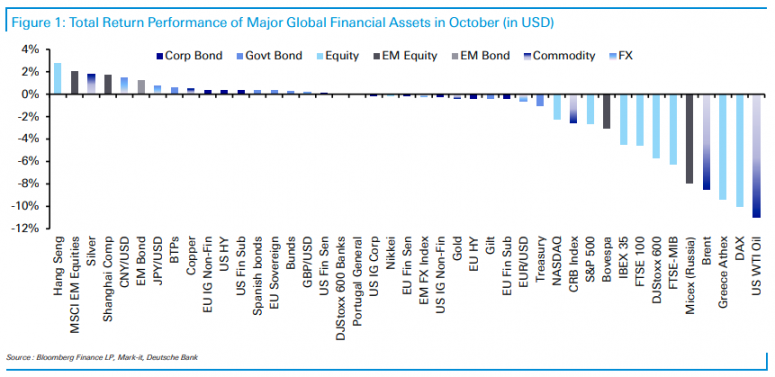Bitcoin (BTC) was lower for a third straight day around $13,500, having fallen back from a fleeting 33-month high of $14,093 over the weekend.
In traditional markets, Asian and European shares rose and U.S. stock futures pointed to a higher open. The yield on 10-year U.S. Treasuries increased 0.03 percentage point to 0.88%. Gold strengthened 0.2% to $1,899 an ounce.
Market Moves
The U.S. presidential election is finally here. President Donald Trump’s Republicans are as convinced that Democratic challenger Joe Biden will lead America down an irreversible path toward socialism and disorder as Democrats are convinced another four years of Trump could well signal the end of democracy and decency.
A lot of bitcoiners are just putting their faith in bitcoin.
None of this may be justified, or perhaps all of it. First Mover decided that the best way to add value as American voters go to the polls was just to jot down a few bitcoin-oriented talking points.
1) Bitcoin prices barely reacted when Trump defeated Hillary Clinton in 2016:
2) Bitcoin’s price action for the entire month of November 2016 gets completely lost in the longer-term chart:
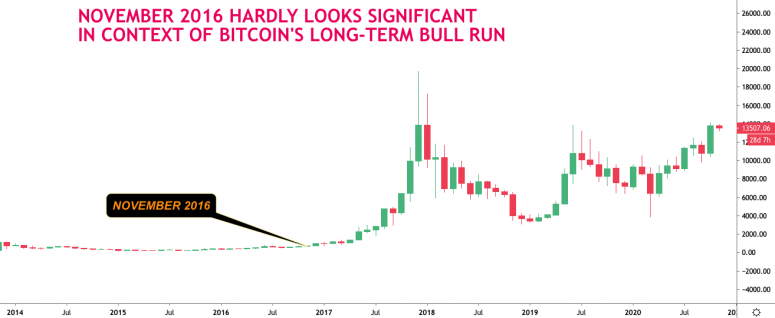
3) A “blue wave” in which Biden wins and Democrats take control of the upper legislative chamber, the U.S. Senate, could make it easy for the former vice president to implement an agenda that includes spending big on societal issues and climate change. Such fiscal stimulus could expand already record U.S. federal budget deficits and probably would have to be financed by the Federal Reserve via money printing. Bitcoin might benefit from an ostensible weakening in the U.S. dollar.
4) A “red wave” in which Republicans hold the presidency and U.S. Congress is viewed as a “low probability” event, according to Reuters, but could lead to a rally in stock prices and a “risk-on” environment for financial assets. That was a pretty bullish environment for bitcoin in the decade through 2019. Trump has promised “massive tax cuts” during a second term along with massive stimulus. That would probably mean the Fed needs to print massive amounts of new money to finance it all.
5) In any scenario, stimulus is the likely winner, as previously reported in this column. “Regardless of the outcome, bitcoin will prosper,” wrote Matt Blom, head of sales and trading at the cryptocurrency-focused financial firm Diginex.
6) The FTX crypto exchange’s TRUMP 2020 futures contracts, which pay out 100 cents on the dollar if the sitting president wins and $0 otherwise, have surged over the past week but are still indicating that Trump is headed for a loss. The tokens were changing hands at 38 cents late Monday. Note that these also pay out if Trump technically loses but is still president after January 2021:
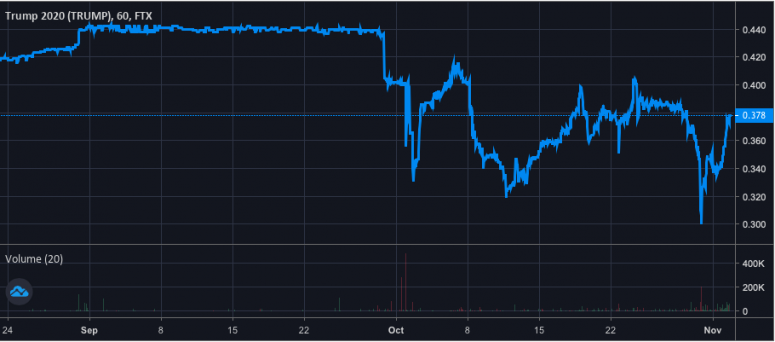
7) A host of key local elections for could shake up the landscape for crypto-industry policymaking for years to come, as reported by CoinDesk’s Nikhilesh De in his pop-up newsletter, State of Crypto: Election 2020.
8) Much of the election handicapping in traditional markets has focused on the potential for steep volatility in the event that there is no clear election result, potentially leading to prolonged uncertainty or even a constitutional crisis. “Should election results lead to turmoil and instability in the U.S., it would make sense” for more people to turn to bitcoin or other cryptocurrencies as they grow “ever weary of central banks and politicians in general,” said Denis Vinokorov of the crypto prime broker Bequant.
9) Because voters have already cast early ballots in unprecedented numbers, the potential for prolonged uncertainty may be overstated, according to Mati Greenspan, founder of the cryptocurrency analysis firm Quantum Economics. It “will be measured in hours, maybe days, and not weeks and months as some expect,” Greenspan told clients in a newsletter. That might mean there’s less to knock bitcoin prices off their medium-term trajectory, which lately has been up.
10) If Biden wins, the next couple months of the “stub period” prior to the mid-January inauguration might see outsize risks as “Republicans aim to avoid aiding an incoming Democratic administration,” according to the Washington Post. Unemployment is elevated, the coronavirus continues to spread and the economy is going through tectonic shifts such as the transition toward remote working. All that means that there’s little likelihood of calm returning to traditional financial markets or crypto markets anytime soon.
11) Trump’s $1.5 trillion of tax cuts in late 2017 boosted employment but never really paid for themselves and thus ballooned the national debt, even before the pandemic hit. As the economy slowed in 2019, the Fed had to loosen monetary policy to keep markets from falling. That helped to rekindle a bull market in bitcoin following the harsh bear market of 2018. Bitcoin took another leg up this year as the Fed pumped $3 trillion into global markets. In the end, the cryptocurrency gained 19-fold over the past four years.
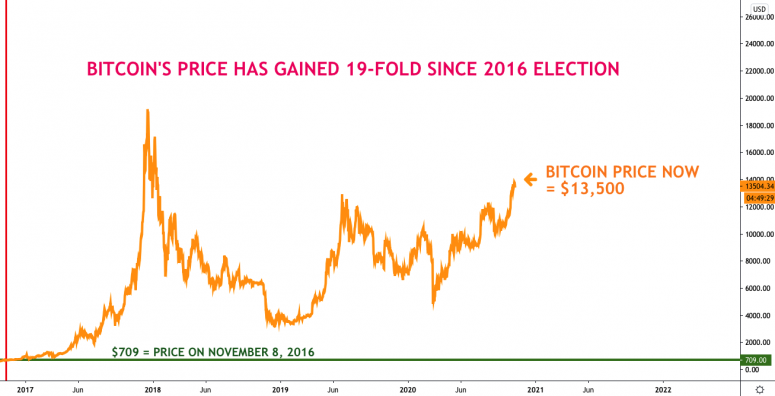
Bitcoin Watch
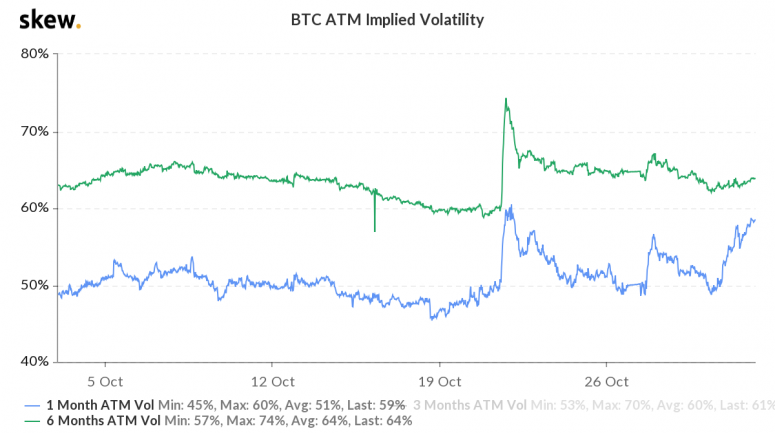
Both bitcoin and traditional market investors look to be predicting a pick-up in volatility following Tuesday’s U.S. elections.
The largest cryptocurrency’s one-month implied volatility – expectations of how turbulent prices will be over the next four weeks, as implied in options markets – has risen to a two-week high of 59% in the past three days, according to data source Skew.
“We expect the cryptocurrency to trade volatile in the coming days,” Matthew Dibb, co-founder of Stack Funds, told CoinDesk.
The heightened short-term price volatility expectations could be associated with fears that the outcome of the election may be contested, resulting in a period of political and economic uncertainty.
While the one-month implied volatility has picked up, the six-month metric remains flat above 60%. That suggests the market does not expect a prolonged period of political uncertainty in the world’s largest economy.
Further, the 10-percentage-point rise in the one-month implied volatility isn’t a big move and indicates a moderate shift in sentiment, according to Vishal Shah, an options trader and founder of derivatives exchange Alpha5.
More extreme sentiment is seen in traditional foreign exchange markets, where the Chinese yuan’s one-week implied volatility has doubled in the past week to the highest since 2011.
One-week implied volatility gauges for the euro and the yen have also risen to the highest since April.
Token Watch
Ether (ETH): Amount of ether held at major centralized cryptocurrency exchanges drops to two-year low as decentralized exchanges grow in popularity.
Bitcoin (BTC): Mining difficulty sees largest percentage drop in 9 years:

What’s Hot
Hong Kong securities watchdog may soon regulate all crypto trading platforms (CoinDesk)
PayPal plans rapid expansion of cryptocurrency service in 2021 (CoinDesk)
It’s the “Super Bowl” of prediction markets as U.S. election spurs volume surge on crypto betting platforms (CoinDesk)
Crypto exchange Huobi denies rumors that senior executive was arrested (CoinDesk)
DeFi trading app Dharma now connects directly to U.S. bank accounts via automated clearing house (ACH) purchases (CoinDesk)
Lightning Labs, leading software team focused on bitcoin’s Lightning Network, releases Pool, a peer-to-peer marketplace allowing users to lend out bitcoin in payment channels in return for yield (CoinDesk)
China’s first-mover advantage on central bank digital currencies might be overblown, since laggards (such as the U.S.) could learn from early mistakes (CoinDesk Opinion)
Digital-asset trading volumes on decentralized exchanges dropped 25% in October after doubling for three consecutive months (CoinDesk):
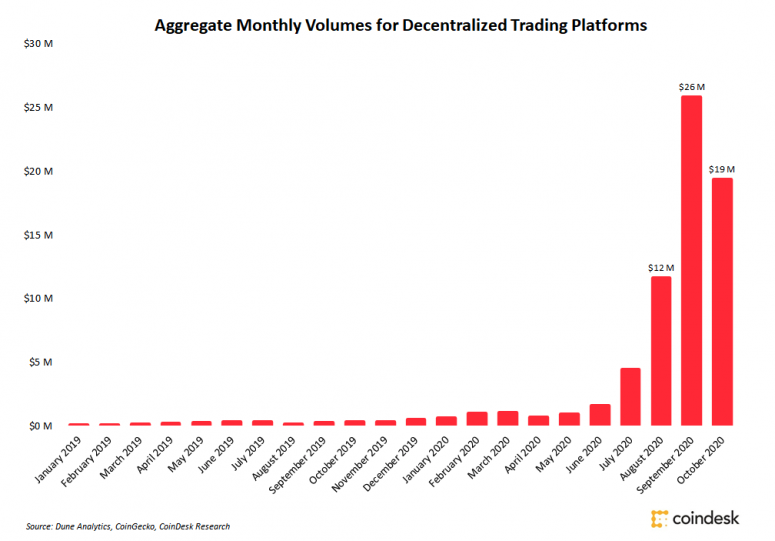
Analogs
The latest on the economy and traditional finance
Australia’s central bank cuts key interest rate to record low, now in a range from 0.1% to 0.25%, and will buy A$100B ($70B) of bonds over next six months (Reuters)
Italian bank Monte dei Paschi CEO reportedly tells board that 1.5B-2B euro of bailout cash is needed to avoid breaching capital requirements (Reuters)
Japanese property investors are feeling the heat as Tokyo urbanites migrate to suburbs (Reuters)
Best performing traditional asset class in October (Hong Kong’s Hang Seng index) gained about 3%, versus bitcoin’s 29% (Deutsche Bank):
